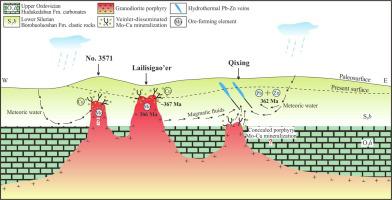当前位置:
X-MOL 学术
›
Ore Geol. Rev.
›
论文详情
Our official English website, www.x-mol.net, welcomes your feedback! (Note: you will need to create a separate account there.)
Genesis of the Nailenggele Mo-Cu-Pb-Zn polymetallic orefield in the Boluokenu Metallogenic Belt, Western Tianshan, China: Constraints from geochronology, fluid inclusions and isotope geochemistry
Ore Geology Reviews ( IF 3.3 ) Pub Date : 2021-02-01 , DOI: 10.1016/j.oregeorev.2020.103940 Yi-Wei Peng , Xue-Xiang Gu , Guo-Xiang Chi , Chun-Ji Xue , Yong-Mei Zhang , Peng Yuan , Yu Wan , Xin-Li Wang
Ore Geology Reviews ( IF 3.3 ) Pub Date : 2021-02-01 , DOI: 10.1016/j.oregeorev.2020.103940 Yi-Wei Peng , Xue-Xiang Gu , Guo-Xiang Chi , Chun-Ji Xue , Yong-Mei Zhang , Peng Yuan , Yu Wan , Xin-Li Wang

|
Abstract The Nailenggele orefield, located in the northwestern Chinese Tianshan Orogenic Belt, is composed of the Lailisigao’er Mo deposit, No. 3571 Cu prospect and Qixing Pb-Zn deposit. Lailisigao’er is a typical porphyry deposit with characteristic veinlet-disseminated ores and potassic, phyllic and propylitic alterations. No. 3571, situated in the peripheral of Lailisigao’er, is characterized by large amounts of oxidized ores at surface with limited intrusions outcropped. Qixing, about 3 km from Lailisigao’er, is characterized by quartz-sulfide veins controlled by fractures. This study aims to examine the genetic relationships between these deposits and/or occurrences, and discuss the significance for further exploration in the orefield and elsewhere in the region. LA-ICP-MS U-Pb dating on zircons from the ore-bearing porphyry in the Lailisigao’er deposit yielded an age of 367.5±4.8 Ma. The molybdenite Re-Os and sphalerite Rb-Sr isochron ages recalculated from previously published data are 365.9±2.1 Ma for Lailisigao’er and 362.0±5.7 Ma for Qixing, respectively, suggesting that they are coeval and both related to the granodiorite porphyries. Three types of fluid inclusions occur in the Mo-bearing quartz from Lailisigao’er, including two-phase aqueous inclusions (Type I), solid mineral-bearing aqueous inclusions (Type II) and CO2-H2O inclusions (Type III). The total homogenization (Th) temperatures cluster from 260 to 320 °C (to liquid) for type I inclusions, 310 to 332 °C (to liquid) for type II inclusions, and 268 to 324 °C (to CO2 phase) for type III inclusions. The salinities are mainly in the ranges of 2.0 – 8.0, 32.9 – 42.0, and 1.4 – 5.5 wt.% NaCleq for type I, II and III inclusions, respectively. By contrast, only type I inclusions were identified in Pb-Zn-bearing quartz from Qixing, with Th values of 149 – 261 °C and salinities of 1.7 – 5.3 wt.% NaCleq. The δ34SCDT values of hydrothermal sulfides from Lailisigao’er, No. 3571 and Qixing range from 2.8‰ to 4.0‰, 4.0‰ to 4.6‰ and 0.7‰ to 4.9‰, respectively. Sulfides from these three locations have uniform Pb isotopic compositions. The (87Sr/86Sr)0 ratios of fluid inclusions (average 0.70971) in Mo-bearing quartz at Lailisigao’er and sphalerite (average 0.71020) at Qixing are similar to those of Mo-mineralized porphyries (average of 0.70886) from Lailisigao’er. The δ18OH2O and δDH2O values of Pb-Zn-bearing quartz from Qixing are similar to those of Mo-bearing quartz from Lailisigao’er, both plotting close to the field of magmatic water but shifted toward the meteoric line. These geochronological, fluid inclusions and isotopic data suggest that the mineralization at different localities in the Nailenggele orefield constitutes part of an integrated magmatic-hydrothermal system centered on the Lailisigao’er porphyry Mo deposit, with the Qixing Pb-Zn polymetallic deposit representing a distal end-member. Both metals and sulfur were dominantly derived from porphyritic intrusions, whereas the ore-forming fluids were initially derived from the magmatic intrusions, with increasing involvement of meteoric water in time and distance from magmatic-hydrothermal center. Fluid immiscibility in the early stage and fluid mixing in the later stage, together with cooling, were responsible for ore precipitation. Based on this mineralization model, it is inferred that concealed porphyry Cu-Mo mineralization may be developed underneath the No. 3571 and Qixing.
更新日期:2021-02-01

























 京公网安备 11010802027423号
京公网安备 11010802027423号